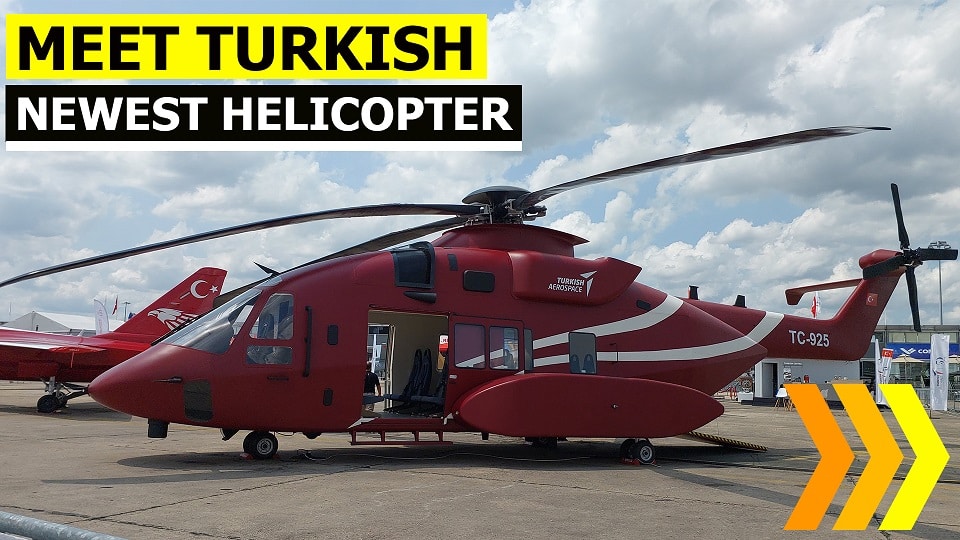Aerospace
Meet Turkish Newest Helicopter T925 Utility Helicopter

Turkish TAI is one of the companies in the aerospace industry that is developing the fastest since it is releasing back-to-back aircraft for the defense industry. The KAAN 5th generation fighter, UAV, and other fighter jets were just recently launched. It is now getting ready to demonstrate its medium-capacity helicopter in competition with the Mi 17.
For the first time, Turkish Aerospace Industries (TAI) is displaying the T925 Utility Helicopter on a full scale. The remarkable TAI products ANKA, AKSUNGUR, T929 Attack Helicopter, and Unmanned Cargo Helicopter are shown alongside the helicopter, which has the tail number “TC-925,” in the static area.
The first flight is scheduled to take place after the T925’s manufacture is finished, which is expected to happen in 2024.
Turkey unveils new T929 heavy attack Helicopter(Opens in a new browser tab)
Temel Kotil, the general manager of TAI, had previously declared that the T925’s inaugural flight would occur on March 18 of that year.
Turkish Aerospace has spent many years developing its idea for a large helicopter. Prior to now, it was believed to be primarily focused on military requirements, possibly displacing larger helicopters currently in use by Turkey’s military.
The Gökbey has a main rotor diameter of 13.20 m and is 15.87 m long, whereas the T925, also known as General Purpose II by Turkish Aerospace Industries CEO Temel Kotil, is 19.95 m long and has a main rotor diameter of 17.3 m. According to Temel Kotil, the General Purpose II actually fills a requirement for expanded transport capacity, notably in terms of passengers. Whereas the T625 can carry 12, the T925 will be able to carry 18.
Turkey’s future trainer jet conducts first flight(Opens in a new browser tab)
Performance-wise, the General Purpose II will be inferior to the Gökbey with a range of 370.4 km and an operational range of up to 3 hours. The service ceiling will be 20,000 feet (or 6096 meters).
- transport of troops and equipment,
- search, and rescue,
- VIP transport,
- firefighting,
- medical transport.
TAI has got more attention from the industry and which is also served the best in class categories. Current plans call for the production of around 24 Gokbey helicopters per year in 2025 and ramping up to as many as 40 a year in 2027.

Aerospace
Boeing Transfers Rocket Stage to NASA, Paving Way for Human Moon Mission

Boeing has achieved a significant milestone by providing NASA with the second core stage of the Space Launch System (SLS) rocket.
This crucial component, crafted at NASA’s Michoud Assembly Facility (MAF), is set to propel the Artemis II crew into lunar orbit, marking humanity’s return to deep space after a 50-year hiatus.
The monumental Boeing-built rocket stage, the largest element of the Artemis II mission, will embark on a journey aboard the Pegasus barge, traveling 900 miles to NASA’s Kennedy Space Center.
Comparison of two legendary aircraft B777x vs B747 aircraft:Click here
Upon arrival, it will be meticulously integrated with other essential Artemis II components, including the upper stage, solid rocket boosters, and NASA’s Orion spacecraft within the iconic Vehicle Assembly Building. This intricate integration process is a vital step toward the eagerly anticipated Artemis II launch, slated for 2025.
“Boeing-built products helped land humankind on the moon in 1969, and we’re proud to continue that legacy through the Artemis generation,” remarked Dave Dutcher, vice president and program manager for Boeing’s SLS program. “Together, with NASA and our industry partners and suppliers, we are building the world’s most capable rocket and paving the way to deep space through America’s rocket factory in New Orleans.”
NASA, Lockheed Martin Reveal X-59 Quiet Supersonic Aircraft:Click here
The delivery of Core Stage 2 marks a significant achievement in the evolution of the SLS rocket. Towering over 200 feet and powered by four RS-25 engines, this core stage, coupled with two solid-fueled booster rockets, will generate a staggering 8.8 million pounds of thrust. This immense power is crucial to launching Artemis II and future missions into the vast expanse of space.
The SLS rocket stands unparalleled in its capability to transport both crew and substantial cargo to the moon and beyond in a single launch. Its extraordinary capacity will facilitate the delivery of human-rated spacecraft, habitats, and scientific missions to destinations including the moon and Mars, ushering in a new era of space exploration.
-

 Travel1 week ago
Travel1 week agoAir India to Expand US Operations with Three New Routes After a Decade
-

 Travel2 weeks ago
Travel2 weeks agoWhy We Should Avoid These Stamps in a Passport
-

 Airlines1 month ago
Airlines1 month agoInvestigations Reveal Fake Chinese Titanium in Boeing and Airbus Jets
-

 Tech4 weeks ago
Tech4 weeks agoChina’s CATL Plans 1,800-Mile Electric Plane Launch by 2027
-

 Airport3 days ago
Airport3 days agoTop 10 Largest Airports in the World by Size
-

 Aerospace4 weeks ago
Aerospace4 weeks agoChina’s Fighter Jets Turn Wings into Autonomous Drones
-

 Airlines4 days ago
Airlines4 days agoAir India Rolls Out A350s for Delhi-New York JFK and Newark Routes
-

 Defence3 weeks ago
Defence3 weeks agoBoeing Enhances Chinook with New Engines and Block II Upgrades at $96 Million







